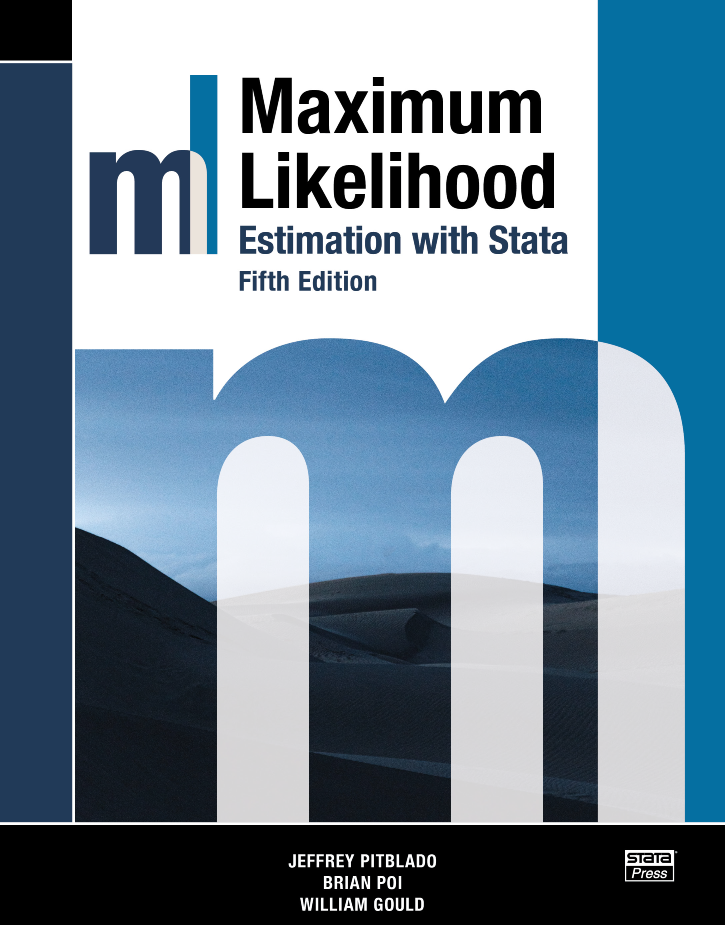Jeffrey Pitblado, Brian Poi, 和 William Gould (作者)

• 出版社: Stata Press
• 出版年份: 2024年
• 平装: 472页
• 语种: 英文
• ISBN: 978-1-59718-411-3
• 条形码: 9781597183598
• 电子版:有
《Stata 最大似然估计》第五版对于希望在 Stata 中编写最大似然 (ML) 估计器的所有学科的研究人员来说是重要的参考和指南。除了全面介绍 Stata 用于编写 ML 估计器的命令之外,本书还概述了最大似然的基础以及如何考虑 ML 估计。
第五版包括新的第二章,演示易于使用的mlexp命令。该命令允许您直接指定似然函数并执行估计,而无需任何编程。
本书的核心重点是Stata的ml命令。它向您展示了如何充分利用ml的值得注意的功能:
• 线性约束
• 四种优化算法(Newton–Raphson、DFP、BFGS 和 BHHH)
• 观测信息矩阵 (OIM) 方差估计器
• 梯度外积 (OPG) 方差估计器
• Huber/White/sandwich 稳健方差估计器
• 集群鲁棒方差估计器
• 对调查数据分析的完整和自动支持
• 直接支持用 Mata 编写的评估器函数
当使用适当的选项时,许多这些功能都是由机器学习自动提供的,不需要编写估计器的研究人员进行特殊编程或干预。
在后面的章节中,您将学习如何利用 Mata(Stata 的矩阵编程语言)。为了简化编程并提高潜在的速度,您可以在 Mata 中编写似然评估器程序,并继续使用机器学习来控制最大化过程。第五版中的新章节展示了如果您想完全在 Mata 中实现最大似然估计器,如何使用 Mata 函数的 moptimize()套件。
在最后一章中,作者说明了从对数似然函数到完全可操作的估计命令所需的主要步骤。这是使用几种不同的模型来完成的:logit 和 probit、线性回归、Weibull 回归、Cox 比例风险模型、随机效应回归和看似不相关的回归。此版本添加了二元泊松模型的新示例,该模型在 Stata 中不可用。
作者为开发您自己的估计命令提供了广泛的建议。只要稍加小心并在本书的帮助下,用户将能够编写自己的估计命令——这些命令的外观和行为与 Stata 中的官方估计命令一样。
无论您是想为自己的研究安装一个特殊的 ML 估计器,还是希望编写一个通用的 ML 估计器供其他人使用,您都需要这本书。
Jeff Pitblado 是 StataCorp 统计软件执行总监。Pitblado 在机器学习的发展中发挥了主导作用:他添加了机器学习处理调查数据的能力,并在 Mata 中 编写了机器学习的当前实现。
Brian Poi 之前曾在 StataCorp 担任开发人员,并在 Stata 中编写了许多流行的计量经济估算器。从那时起,他将计量经济学和统计编程知识应用于多个领域,包括宏观经济预测、信贷分析和银行压力测试。
William Gould 是 StataCorp 的名誉总裁,领导 Stata 的开发已有 30 多年。古尔德也是马塔的建筑师。
List of tables
List of figures
Preface to the Second Edition
Preface to the First Edition
1 Stata basics
1.1 Interactive use
1.2 Documentation
1.3 Command syntax and operators
1.4 Do-files and log files
1.5 Scalars and matrices
1.6 Using results from Stata commands
1.7 Global and local macros
1.8 Looping commands
1.9 Mata and Python in Stata
1.10 Some useful commands
1.11 Template do-file
1.12 Community-contributed commands
1.13 Additional resources
1.14 Exercises
2 Data management and graphics
2.1 Introduction
2.2 Types of data
2.3 Inputting data
2.4 Data management
2.5 Manipulating datasets
2.6 Graphical display of data
2.7 Additional resources
2.8 Exercises
3 Linear regression basics
3.1 Introduction
3.2 Data and data summary
3.3 Transformation of data before regression
3.4 Linear regression
3.5 Basic regression analysis
3.6 Specification analysis
3.7 Specification tests
3.8 Sampling weights
3.9 OLS using Mata
3.10 Additional resources
3.11 Exercises
4 Linear regression extensions
4.1 Introduction
4.2 In-sample prediction
4.3 Out-of-sample prediction
4.4 Predictive margins
4.5 Marginal effects
4.6 Regression decomposition analysis
4.7 Shapley decomposition of relative regressor importance
4.8 Differences-in-differences estimators
4.9 Additional resources
4.10 Exercises
5 Simulation
5.1 Introduction
5.2 Pseudorandom-number generators
5.3 Distribution of the sample mean
5.4 Pseudorandom-number generators: Further details
5.5 Computing integrals
5.6 Simulation for regression: Introduction
5.7 Additional resources
5.8 Exercises
6 Linear regression with correlated errors
6.1 Introduction
6.2 Generalized least-squares and FGLS regression
6.3 Modeling heteroskedastic data
6.4 OLS for clustered data
6.5 FGLS estimators for clustered data
6.6 Fixed-effects estimator for clustered data
6.7 Linear mixed models for clustered data
6.8 Systems of linear regressions
6.9 Survey data: Weighting, clustering, and stratification
6.10 Additional resources
6.11 Exercises
7 Linear instrumental-variables regression
7.1 Introduction
7.2 Simultaneous equations model
7.3 Instrumental-variables estimation
7.4 Instrumental-variables example
7.5 Weak instruments
7.6 Diagnostics and tests for weak instruments
7.7 Inference with weak instruments
7.8 Finite sample inference with weak instruments
7.9 Other estimators
7.10 Three-stage least-squares systems estimation
7.11 Additional resources
7.12 Exercises
8 Linear panel-data models: Basics
8.1 Introduction
8.2 Panel-data methods overview
8.3 Summary of panel data
8.4 Pooled or population-averaged estimators
8.5 Fixed-effects or within estimator
8.6 Between estimator
8.7 Random-effects estimator
8.8 Comparison of estimators
8.9 First-difference estimator
8.10 Panel-data management
8.11 Additional resources
8.12 Exercises
9 Linear panel-data models: Extensions
9.1 Introduction
9.2 Panel IV estimation
9.3 Hausman–Taylor estimator
9.4 Arellano–Bond estimator
9.5 Long panels
9.6 Additional resources
9.7 Exercises
10 Introduction to nonlinear regression
10.1 Introduction
10.2 Binary outcome models
10.3 Probit model
10.4 MEs and coefficient interpretation
10.5 Logit model
10.6 Nonlinear least squares
10.7 Other nonlinear estimators
10.8 Additional resources
10.9 Exercises
11 Tests of hypotheses and model specification
11.1 Introduction
11.2 Critical values and p-values
11.3 Wald tests and confidence intervals
11.4 Likelihood-ratio tests
11.5 Lagrange multiplier test (or score test)
11.6 Multiple testing
11.7 Test size and power
11.8 The power onemean command for multiple regression
11.9 Specification tests
11.10 Permutation tests and randomization tests
11.11 Additional resources
11.12 Exercises
12 Bootstrap methods
12.1 Introduction
12.2 Bootstrap methods
12.3 Bootstrap pairs using the vce(bootstrap) option
12.4 Bootstrap pairs using the bootstrap command
12.5 Percentile-t bootstraps with asymptotic refinement
12.6 Wild bootstrap with asymptotic refinement
12.7 Bootstrap pairs using bsample and simulate
12.8 Alternative resampling schemes
12.9 The jackknife
12.10 Additional resources
12.11 Exercises
13 Nonlinear regression methods
13.1 Introduction
13.2 Nonlinear example: Doctor visits
13.3 Nonlinear regression methods
13.4 Different estimates of the VCE
13.5 Prediction
13.6 Predictive margins
13.7 Marginal effects
13.8 Model diagnostics
13.9 Clustered data
13.10 Additional resources
13.11 Exercises
14 Flexible regression: Finite mixtures and nonparametric
14.1 Introduction
14.2 Models based on finite mixtures
14.3 FMM example: Earnings of doctors
14.4 Global polynomials
14.5 Regression splines
14.6 Nonparametric regression
14.7 Partially parametric regression
14.8 Additional resources
14.9 Exercises
15 Quantile regression
15.1 Introduction
15.2 Conditional quantile regression
15.3 CQR for medical expenditures data
15.4 CQR for generated heteroskedastic data
15.5 Quantile treatment effects for a binary treatment
15.6 Additional resources
15.7 Exercises
A Programming in Stata
A.1 Stata matrix commands
A.2 Programs
A.3 Program debugging
A.4 Additional resources
B Mata
B.1 How to run Mata
B.2 Mata matrix commands
B.3 Programming in Mata
B.4 Additional resources
C Optimization in Mata
C.1 Mata moptimize() function
C.2 Mata optimize() function
C.3 Additional resources
Glossary of abbreviations
References
Author index
Subject index
List of tables
List of figures
16 Nonlinear optimization methods
16.1 Introduction
16.2 Newton–Raphson method
16.3 Gradient methods
16.4 Overview of ml, moptimize(), and optimize()
16.5 The ml command: lf method
16.6 Checking the program
16.7 The ml command: lf0–lf2, d0–d2, and gf0 methods
16.8 Nonlinear instrumental-variables (GMM) example
16.9 Additional resources
16.10 Exercises
17 Binary outcome models
17.1 Introduction
17.2 Some parametric models
17.3 Estimation
17.4 Example
17.5 Goodness of fit and prediction
17.6 Marginal effects
17.7 Clustered data
17.8 Additional models
17.9 Endogenous regressors
17.10 Grouped and aggregate data
17.11 Additional resources
17.12 Exercises
18 Multinomial models
18.1 Introduction
18.2 Multinomial models overview
18.3 Multinomial example: Choice of fishing mode
18.4 Multinomial logit model
18.5 Alternative-specific conditional logit model
18.6 Nested logit model
18.7 Multinomial probit model
18.8 Alternative-specific random-parameters logit
18.9 Ordered outcome models
18.10 Clustered data
18.11 Multivariate outcomes
18.12 Additional resources
18.13 Exercises
19 Tobit and selection models
19.1 Introduction
19.2 Tobit model
19.3 Tobit model example
19.4 Tobit for lognormal data
19.5 Two-part model in logs
19.6 Selection models
19.7 Nonnormal models of selection
19.8 Prediction from models with outcome in logs
19.9 Endogenous regressors
19.10 Missing data
19.11 Panel attrition
19.12 Additional resources
19.13 Exercises
20 Count-data models
20.1 Introduction
20.2 Modeling strategies for count data
20.3 Poisson and negative binomial models
20.4 Hurdle model
20.5 Finite-mixture models
20.6 Zero-inflated models
20.7 Endogenous regressors
20.8 Clustered data
20.9 Quantile regression for count data
20.10 Additional resources
20.11 Exercises
21 Survival analysis for duration data
21.1 Introduction
21.2 Data and data summary
21.3 Survivor and hazard functions
21.4 Semiparametric regression model
21.5 Fully parametric regression models
21.6 Multiple-records data
21.7 Discrete-time hazards logit model
21.8 Time-varying regressors
21.9 Clustered data
21.10 Additional resources
21.11 Exercises
22 Nonlinear panel models
22.1 Introduction
22.2 Nonlinear panel-data overview
22.3 Nonlinear panel-data example
22.4 Binary outcome and ordered outcome models
22.5 Tobit and interval-data models
22.6 Count-data models
22.7 Panel quantile regression
22.8 Endogenous regressors in nonlinear panel models
22.9 Additional resources
22.10 Exercises
23 Parametric models for heterogeneity and endogeneity
23.1 Introduction
23.2 Finite mixtures and unobserved heterogeneity
23.3 Empirical examples of FMMs
23.4 Nonlinear mixed-effects models
23.5 Structural equation models for linear structural equation models
23.6 Generalized structural equation models
23.7 ERM commands for endogeneity and selection
23.8 Additional resources
23.9 Exercises
24 Randomized control trials and exogenous treatment effects
24.1 Introduction
24.2 Potential outcomes
24.3 Randomized control trials
24.4 Regression in an RCT
24.5 Treatment evaluation with exogenous treatment
24.6 Treatment evaluation methods and estimators
24.7 Stata commands for treatment evaluation
24.8 Oregon Health Insurance Experiment example
24.9 Treatment-effect estimates using the OHIE data
24.10 Multilevel treatment effects
24.11 Conditional quantile TEs
24.12 Additional resources
24.13 Exercises
25 Endogenous treatment effects
25.1 Introduction
25.2 Parametric methods for endogenous treatment
25.3 ERM commands for endogenous treatment
25.4 ET commands for binary endogenous treatment
25.5 The LATE estimator for heterogeneous effects
25.6 Difference-in-differences and synthetic control
25.7 Regression discontinuity design
25.8 Conditional quantile regression with endogenous regressors
25.9 Unconditional quantiles
25.10 Additional resources
25.11 Exercises
26 Spatial regression
26.1 Introduction
26.2 Overview of spatial regression models
26.3 Geospatial data
26.4 The spatial weighting matrix
26.5 OLS regression and test for spatial correlation
26.6 Spatial dependence in the error
26.7 Spatial autocorrelation regression models
26.8 Spatial instrumental variables
26.9 Spatial panel-data models
26.10 Additional resources
26.11 Exercises
27 Semiparametric regression
27.1 Introduction
27.2 Kernel regression
27.3 Series regression
27.4 Nonparametric single regressor example
27.5 Nonparametric multiple regressor example
27.6 Partial linear model
27.7 Single-index model
27.8 Generalized additive models
27.9 Additional resources
27.10 Exercises
28 Machine learning for prediction and inference
28.1 Introduction
28.2 Measuring the predictive ability of a model
28.3 Shrinkage estimators
28.4 Prediction using lasso, ridge, and elasticnet
28.5 Dimension reduction
28.6 Machine learning methods for prediction
28.7 Prediction application
28.8 Machine learning for inference in partial linear model
28.9 Machine learning for inference in other models
28.10 Additional resources
28.11 Exercises
29 Bayesian methods: Basics
29.1 Introduction
29.2 Bayesian introductory example
29.3 Bayesian methods overview
29.4 An i.i.d. example
29.5 Linear regression
29.6 A linear regression example
29.7 Modifying the MH algorithm
29.8 RE model
29.9 Bayesian model selection
29.10 Bayesian prediction
29.11 Probit example
29.12 Additional resources
29.13 Exercises
30 Bayesian methods: Markov chain Monte Carlo algorithms
30.1 Introduction
30.2 User-provided log likelihood
30.3 MH algorithm in Mata
30.4 Data augmentation and the Gibbs sampler in Mata
30.5 Multiple imputation
30.6 Multiple-imputation example
30.7 Additional resources
30.8 Exercises
Glossary of abbreviations
References
 北京友万信息科技有限公司,英文全称:Beijing Uone Info&Tech Co.,Ltd ( Uone-Tech )是中国大陆领先的教育和科学软件分销商,已在中国300多所高校建立了可靠的分销渠道。拥有最成功的教学资源和数据管理专家。如需申请软件采购及老版本更新升级请联系我们,咨询热线:010-56548231 ,咨询邮箱:info@uone-tech.cn 感谢您的支持与关注。
北京友万信息科技有限公司,英文全称:Beijing Uone Info&Tech Co.,Ltd ( Uone-Tech )是中国大陆领先的教育和科学软件分销商,已在中国300多所高校建立了可靠的分销渠道。拥有最成功的教学资源和数据管理专家。如需申请软件采购及老版本更新升级请联系我们,咨询热线:010-56548231 ,咨询邮箱:info@uone-tech.cn 感谢您的支持与关注。